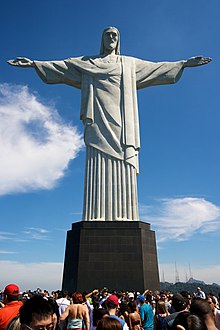Charnockite
Charnockites are rocks with a granite-like composition and igneous structure . The name Charnockit is derived from the name of the founder of Calcutta , Job Charnock (1630–1692), whose mausoleum was built from a Charnockit. The first scientific description was made in 1893 (Journal of the Asiatic Society of Bengal) and 1900 (Memoirs of the Geological Society of India) by Thomas Henry Holland , the state geologist responsible for India , who named it after the rock used for the burial site from the deposits on St. Thomas Mount coined.
Mineral inventory and occurrence

Their mineral stocks contain potassium feldspar , orthopyroxene ( ferrosilite ), plagioclase and quartz . There is no water- containing silicates such as hornblende and mica . The honey-yellow to green coloring of the potash feldspars and the unusual greasy sheen of the feldspars are particularly typical . Charnockites occur mainly in deeply eroded , Precambrian basement mountains in Africa, Antarctica, India and northeastern South America. There is no such rock occurrence in Central Europe, only in Scandinavia there are smaller occurrences.

Emergence
In petrology , until recently there was the view that the Charnockites belong to the granites, i.e. are of magmatic origin. In the meantime it has been proven that at least some of the Charnockites are due to metamorphic processes. Charnockites arise in the middle earth's crust at high temperatures of 650 to almost 900 ° C and a pressure of 3 to 6 kbar . They are surrounded by metamorphic rocks from which they were melted at the high temperatures. This resulted in a separation of water-containing magma with low viscosity , which rose from the place of melting into higher crust areas, from a low-water, viscous residual melt, which crystallized to a charnockite.
The metamorphic Charnockites are formed when fluids containing CO 2 flow along slate surfaces or shear zones . As a result, the original rock, which has been partially transformed, has a spotty or streaky appearance; in the English specialist literature this is referred to as incipient charnockite . By reducing the CO 2 fluids, graphite and other microscopically fine minerals are precipitated at the boundaries of mineral grains and in microcracks . These inclusions, which mostly follow special crystallographic directions, give the feldspars a greasy sheen, orthopyroxene gets a metallic sheen and quartz shows a blue color due to the finest rutile needles enclosed . The isotope analysis of liquid inclusions in crystals and graphite confirms that the CO 2 originates from the upper mantle of the earth .
use
Charnockite deposits are mined in India, Brazil and Nigeria and exported as stone to Europe and North America . Especially in the 1960s, Charnockites were used as gravestones in Germany. In the countries of origin, they are also used in part for gravel and road construction. The base for the world-famous statue of Christ in Rio de Janeiro consists of a charnockite, the Verde Ubatuba .
Charnockites can lighten up when used outdoors as polished natural stones , such as the Verde Ubatuba. In general, these rocks are frost and acid resistant and can be polished.
Natural stone types
- Verde Ubatuba (Brazil, State of Rio de Janeiro, Ubatuba )
- Blue Star (India, Andra Pradesh State, Warangal )
- Jos Dark Green (Nigeria, Jos )
- Varberg, (Sweden, Varberg )
literature
- W. Maresch, O. Medenbach: Rocks. Mosaik Verlag, 1987, ISBN 3-576-10699-5 , p. 234.
- Friedrich Müller : INSK compact. Sheet 16.3. Ebner Verlag, Ulm o. J.
- Friedrich Müller: Geology. Textbook and reference work on rocks for building construction, interior design, art and restoration. 6th edition. completely revised. Ebner Verlag, Ulm 2001, ISBN 3-87188-122-8 , p. 82.
- M. Yoshida, M. Santosh (Eds.): Granulites of India, Sri Lanka and Antarctica. In: Gondwana Research Memoir. 1, Osaka 1995, ISBN 4-9900375-1-0 .
Web links
Individual evidence
- ↑ Charnockite . In: Encyclopædia Britannica . 11th edition. tape 5 : Calhoun - Chatelaine . London 1910, p. 947 (English, full text [ Wikisource ]).
- ↑ Geological Survey of India ( Memento of the original from July 21, 2011 in the Internet Archive ) Info: The archive link was automatically inserted and not yet checked. Please check the original and archive link according to the instructions and then remove this notice. Retrieved November 20, 2009
- ↑ Hans Wieseneder : Comments on Topics of the XXII. International Geological Congress in New Delhi (India) (PDF)
- ^ FH Hubbard, JE Whitley: Rapakivi granite, anorthosite and charnockitic plutonism. In: Nature. 271, 1978, pp. 439-440.
- ^ M. Yoshida, M. Santosh: A tectonic perspective of incipient charnockites in East Gondwana. In: Precambrian Research. 66, 1994, pp. 379-392.
- ↑ Verde Ubatuba. at: natursteinonline.de , accessed on July 21, 2013.

